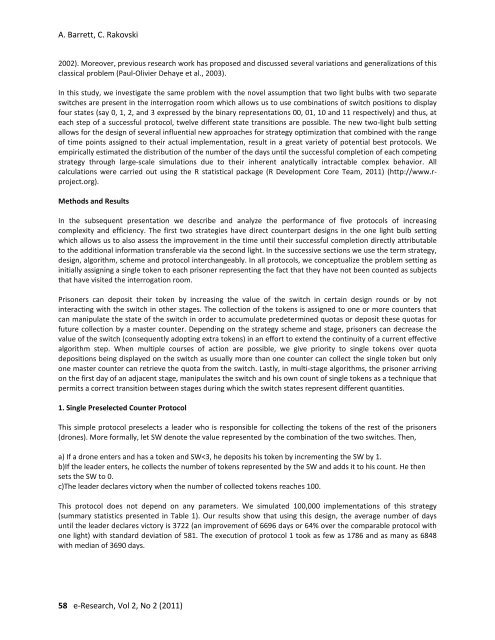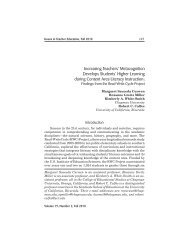e-Research: A Journal of Undergraduate Work - Chapman University
e-Research: A Journal of Undergraduate Work - Chapman University
e-Research: A Journal of Undergraduate Work - Chapman University
You also want an ePaper? Increase the reach of your titles
YUMPU automatically turns print PDFs into web optimized ePapers that Google loves.
A. Barrett, C. Rakovski<br />
2002). Moreover, previous research work has proposed and discussed several variations and generalizations <strong>of</strong> this<br />
classical problem (Paul-Olivier Dehaye et al., 2003).<br />
In this study, we investigate the same problem with the novel assumption that two light bulbs with two separate<br />
switches are present in the interrogation room which allows us to use combinations <strong>of</strong> switch positions to display<br />
four states (say 0, 1, 2, and 3 expressed by the binary representations 00, 01, 10 and 11 respectively) and thus, at<br />
each step <strong>of</strong> a successful protocol, twelve different state transitions are possible. The new two-light bulb setting<br />
allows for the design <strong>of</strong> several influential new approaches for strategy optimization that combined with the range<br />
<strong>of</strong> time points assigned to their actual implementation, result in a great variety <strong>of</strong> potential best protocols. We<br />
empirically estimated the distribution <strong>of</strong> the number <strong>of</strong> the days until the successful completion <strong>of</strong> each competing<br />
strategy through large-scale simulations due to their inherent analytically intractable complex behavior. All<br />
calculations were carried out using the R statistical package (R Development Core Team, 2011) (http://www.rproject.org).<br />
Methods and Results<br />
In the subsequent presentation we describe and analyze the performance <strong>of</strong> five protocols <strong>of</strong> increasing<br />
complexity and efficiency. The first two strategies have direct counterpart designs in the one light bulb setting<br />
which allows us to also assess the improvement in the time until their successful completion directly attributable<br />
to the additional information transferable via the second light. In the successive sections we use the term strategy,<br />
design, algorithm, scheme and protocol interchangeably. In all protocols, we conceptualize the problem setting as<br />
initially assigning a single token to each prisoner representing the fact that they have not been counted as subjects<br />
that have visited the interrogation room.<br />
Prisoners can deposit their token by increasing the value <strong>of</strong> the switch in certain design rounds or by not<br />
interacting with the switch in other stages. The collection <strong>of</strong> the tokens is assigned to one or more counters that<br />
can manipulate the state <strong>of</strong> the switch in order to accumulate predetermined quotas or deposit these quotas for<br />
future collection by a master counter. Depending on the strategy scheme and stage, prisoners can decrease the<br />
value <strong>of</strong> the switch (consequently adopting extra tokens) in an effort to extend the continuity <strong>of</strong> a current effective<br />
algorithm step. When multiple courses <strong>of</strong> action are possible, we give priority to single tokens over quota<br />
depositions being displayed on the switch as usually more than one counter can collect the single token but only<br />
one master counter can retrieve the quota from the switch. Lastly, in multi-stage algorithms, the prisoner arriving<br />
on the first day <strong>of</strong> an adjacent stage, manipulates the switch and his own count <strong>of</strong> single tokens as a technique that<br />
permits a correct transition between stages during which the switch states represent different quantities.<br />
1. Single Preselected Counter Protocol<br />
This simple protocol preselects a leader who is responsible for collecting the tokens <strong>of</strong> the rest <strong>of</strong> the prisoners<br />
(drones). More formally, let SW denote the value represented by the combination <strong>of</strong> the two switches. Then,<br />
a) If a drone enters and has a token and SW







